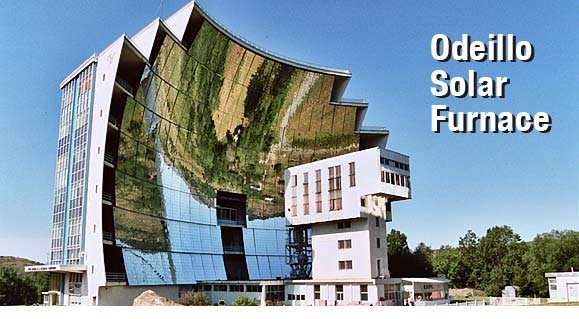Solar Furnaces: Concentrated Solar Radiation
Solar furnaces use a curved mirror,or an array of mirrors, acting as a parabolic reflector to concentrate light towards a focal point which may reach temperatures of up to 3,000 degrees celsius. This heat can be used to generate electricity, melt rock or metals or make hydrogen fuel. There are several types of solar furnaces, each of which produces a different wattage of power.
The best known solar furnace is called a high-flux solar furnace. It uses just one flat mirror or heliostat that is very large in size and tracks the sun to ensure the greatest reflection of sunlight onto the primary concentrator. The concentrator consists of twenty-five or so individual curved mirrors. These mirrors focus the light, called a solar flux, at a target inside the furnace.
The light from the concentrator is focused on a circle or target inside the furnace. The focused beam of light created by the concentrator is much, much stronger than normal sunlight. At its focal point it can produce the energy of 2,500 suns. There can also be a reflective secondary concentrator added to the focus. The equivalent of up 20,000 suns can then be produced. When a refractive concentrator is added to the system to focus even more light on the beam, the intensity can equal an amazing 50,000 suns. Temperatures rise very rapidly in a solar furnace, more than 1,832 F (1,000 C) per second. The power level inside the furnace is adjustable by a device called an attenuator, which works like pulling down blinds over a window.
Solar furnaces are primarily used to generate heat or steam to make electricity and for industrial use. Steam created by solar furnaces can be used to run generators and industrial equipment. An advantage of using solar-created heat in such industrial processes is that the heat is clean, meaning that it produces no harmful emissions. The first solar furnace was designed in Germany in 1921. It used a parabolic concentrator and lenses. Several more were built in Germany, France, and the United States between the 1930s and 1950s. One built in France in 1952 could produce 50 kilowatt hours of electricity.
In 1970 one of the most powerful solar furnaces built was constructed in Odeillo, in the French Pyreneees, one of the sunniest points in Europe. It can produce about 100 kilowatt hours of electricity and has the capability of making heat as hot as 59,432F (33,000C). On the hillside opposite the furnace are 9,600 to 11,000 flat mirrors over 1,860 square miles (4,817 square kilometers) that track the sun and reflect sunlight onto one side of the furnace. On this side of the ten-story furnace are curved mirrors that cover its face. These mirrors are joined together to act as one large mirror. They focus the sun's energy onto an area that is less than 10 square feet (1 square meter) in order to create the high temperatures. This solar furnace is primarily used for scientific experiments on high temperature applications.
As yet there are still only a few solar furnaces in working order. Besides the one in Odeillo, France, they include smaller ones in China and the United States. The solar furnace in the United States is located at the National Renewable Energy Laboratory's CSR (Concentrated Solar Radiation) User Facility in Golden, Colorado. A high-flux solar furnace, it was built in 1990 and puts out 10 kilowatts of power. It is used to experiment on how solar furnaces can be used in industry.
The future uses of solar furnaces are being determined by furnaces such as the one at the CSR User Facility. There, experiments are being conducted with ceramics, surface hardening, coatings, and processes related to the processing of silicon. It is believed that solar furnaces can be used in manufacturing in the production of aerospace products, defense products, and in electronics. Solar furnaces also could be used to break down and destroy toxic waste. In these uses the highflux solar furnace would replace laser furnaces and furnaces using fossil fuels.
Solar furnace technology has existed for many years but never has been fully explored or used on a widespread commercial basis. It is unclear if solar furnaces will ever be used on any type of scale because of the limitations in their placement and use. However, the research happening at the CSR User Facility and others like it could lead to breakthroughs that improve the technology and/or lower the cost.
Solar Furnaces: Concentrated Solar Radiation copyright 2011 Digtheheat.com

